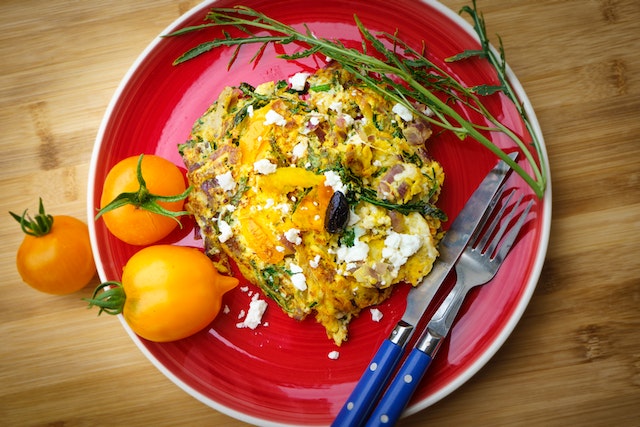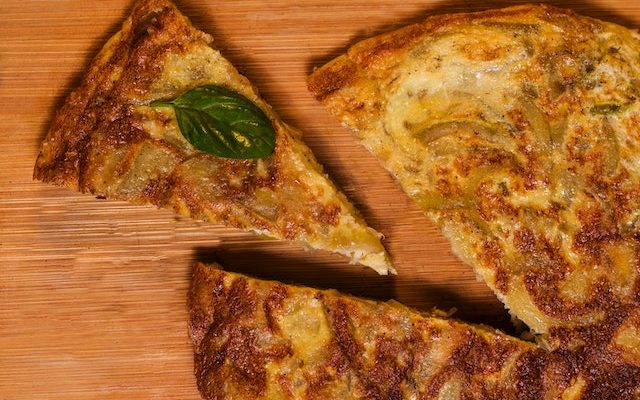Are you in the mood for something hearty, savory, and delicious? If so, what’s better than a classic frittata vs omelet? Or is it even possible to choose between them? In this blog post, we take an in-depth look at these two popular brunch dishes to explore the similarities and differences. We examine their ingredients, how they’re cooked, nutritional value, and more. You will walk away with valuable information when deciding which one of these dishes should be served next time you’re having guests over!
Table of Contents
About Frittata
A frittata is a type of egg-based Italian dish that can be enjoyed for breakfast, lunch, or dinner. It begins by cooking eggs in a skillet with other ingredients like vegetables, cheese, and meats. Unlike an omelet, a frittata is not folded over but instead baked in the oven until it is cooked through.
Frittata recipes vary widely depending on the ingredients used. Common ingredients include potatoes, onions, peppers, mushrooms, bacon, and sausage as well as cheeses like feta and mozzarella. Other add-ins may include spinach leaves or other greens like kale or arugula; herbs such as parsley or basil; tomatoes; and even olives or capers. The possibilities are endless!
An important part of making a successful frittata is to use a non-stick skillet so that the egg mixture doesn’t stick to the pan and allows you to easily slide it out later when ready to serve. Frittatas are also often flipped halfway through baking so that they cook evenly on both sides.
Once finished baking in the oven, frittatas can be served hot with salsa or tomato sauce for added flavor. Additionally, leftover slices can easily be stored in an airtight container for up to three days and re-heated in either the microwave or oven when desired.
Frittatas make delicious meals at any time of day and can be prepared with whatever ingredients you have on hand to create tasty variations – some even make use of leftovers from previous dinners! They’re easy to customize too – just add additional vegetables and seasonings if desired during cooking for a unique twist each time you prepare one!

How Do You Make A Frittata?
Ingredients:
– 8 large eggs
– 1/4 cup half and half
– 1/2 teaspoon salt
– 1/4 teaspoon black pepper
– 2 tablespoons unsalted butter, divided
– 2 cloves garlic, minced
– 1 shallot, minced
– 1 medium zucchini, chopped into small cubes
– 8 ounces mushrooms, sliced thin
– 3 cups baby spinach or kale leaves, roughly chopped
– 2 cups shredded cheese (cheddar, swiss, or mozzarella work great)
Instructions:
– Preheat oven to 350°F. Grease a 9” round baking dish with the remaining tablespoon of butter. Set aside.
– In a medium bowl, whisk together the eggs, half and half, salt and pepper until combined. Set aside.
– Heat a large skillet over medium high heat and melt one tablespoon of butter in the pan. Add the garlic and shallot to the pan and sauté for about two minutes until fragrant and softened.
– Add the zucchini cubes to the pan and cook for three more minutes until slightly softened – stirring occasionally so that everything cooks evenly.
– Add mushrooms to the pan and continue cooking for another five minutes until both vegetables are soft and cooked through – stirring occasionally so that everything cooks evenly throughout this process as well.
– Reduce heat to low and add in spinach or kale leaves to the vegetables in the skillet; cook for two more minutes until wilted before removing from heat completely.
– Pour egg mixture into prepared baking dish followed by vegetables from skillet; stir together with a spatula or spoon so that everything is evenly distributed in the dish before sprinkling cheese on top of frittata mixture in dish as desired (you can also add any other desired ingredients such as bacon bits).
– Place frittata in preheated oven on middle rack and bake for 25-30 minutes until eggs have set completely and cheese is melted on top (you will know your frittata is done when you insert a knife into it that comes out clean).
– Carefully remove frittata from oven once finished baking; let cool 5 minutes before serving warm with desired accompaniments such as sour cream or freshly diced tomatoes! Enjoy!
What Are Some Variations Of A Frittata?
A frittata is an Italian egg-based dish that consists of beaten eggs cooked with a variety of ingredients, including meat, cheese, and vegetables. It can be served hot or cold, as an appetizer or main course. Frittatas are versatile and easy to make, making them a popular choice for brunch or light meals.
The base of a frittata is always eggs, which are whisked together with salt, pepper, and other seasonings before being cooked in a skillet over medium heat. From there you can add a variety of ingredients to create different variations on the classic dish. Here are some delicious frittata variations to try:
– Prosciutto & Arugula Frittata: This flavorful frittata is made with prosciutto ham and arugula leaves sautéed in butter before adding beaten eggs. Grated Parmesan cheese adds extra creaminess and flavor.
– Spinach & Feta Frittata: Spinach and feta cheese are the perfect pairing for this tasty Mediterranean-style frittata. Sautee spinach in olive oil until wilted then add crumbled feta before pouring in the egg mixture.
– Roasted Vegetable Frittata: Roasted vegetables like bell peppers, mushrooms and zucchini make for an incredibly flavorful frittata that’s loaded with nutrients. Sauté the vegetables first then mix them into the egg mixture before baking in the oven until golden brown.
– Greek Frittata: This delicious variation on the classic frittata gets its flavor from Kalamata olives, feta cheese and herbs like oregano and thyme. Add crumbled feta after cooking the egg mixture then top with freshly chopped olives just before serving.
– Bacon & Cheese Frittata: Who doesn’t love bacon? To make this hearty breakfast favorite, cook strips of bacon in a skillet until crisp before adding shredded cheddar cheese to the pan just long enough for it to melt slightly into the eggs.
For those looking for something lighter but still full of flavor, try making a zucchini & ricotta frittata using grated zucchini sautéed with garlic and onion along with creamy ricotta cheese folded into beaten eggs. Or go Mexican-style by adding black beans, pico de gallo salsa and Monterey Jack cheese to your favorite recipe! You can even get creative by using canned salmon or shrimp mixed into your egg mixture for a seafood twist on this Italian classic dish!
About Omelet
An omelet is a classic breakfast dish that can be made in a variety of styles. It typically consists of beaten eggs that are cooked in a hot skillet with butter or oil, and then filled with ingredients such as cheese, vegetables, meats, and herbs. An omelet can also be served open-faced or folded over the fillings.
Omelets are said to have originated in France during the mid-1600s and were commonly served as a street food at the same time. It was not until the early 19th century that omelets began to be served as restaurant fare. Over time, various recipes were developed to create different types of omelets including cheese omelets, Denver omelets, Western omelets and French omelets.
Cheese omelets are one of the most popular varieties of this dish which includes melted cheese inside the egg mixture. They can be prepared using several types of cheeses such as cheddar, Swiss or mozzarella for added flavor. Denver omelets consist of diced ham, onions and red or green peppers cooked together inside the egg mixture before it is folded over. Western type includes diced ham and bell peppers cooked within the eggs while French version generally contains mushrooms and other vegetables like tomatoes and spinach mixed into the eggs before it’s cooked to perfection.
In addition to being delicious and versatile, an omelet is also healthy because it contains proteins from eggs which helps build muscle tissue and strength bones. The protein content also makes them filling enough to provide energy throughout morning hours when consumed for breakfast. Omelet fillings can also offer extra nutrients such as potassium from vegetables like broccoli or mushrooms, calcium from dairy products like cheese or yogurt, iron from meats like bacon or sausage and even fiber if whole wheat bread is used instead of white bread when accompanying an omelet meal.

How Do You Make A Omelet?
Making a delicious omelet is not as difficult as it may seem! With just a few basic ingredients and simple instructions, anyone can whip up a tasty omelet in no time.
Ingredients:
– 3 large eggs
– 2 tablespoons of butter or oil
– ¼ cup of shredded cheese (optional)
– Salt and pepper to taste (optional)
– Fillings such as diced vegetables, herbs, cooked meat, or other chopped ingredients of your choice (optional)
Instructions:
– Heat the butter or oil in an 8 to 10 inch nonstick pan over medium heat. Swirl the pan so that the entire surface is greased.
– Crack all three eggs into a bowl and whisk until fully combined. Pour the eggs into the hot pan and let cook for about 1 minute until edges begin to set.
– Using a spatula, lift edge of omelette and tilt pan so that uncooked egg flows underneath edge of omelette, allowing it to cook evenly on the bottom layer.
– Add cheese, salt and pepper, and any fillings if desired at this point.* Let cook until bottom layer has set but top still looks slightly wet – approximately 2 minutes total cooking time – before folding in half onto itself in the middle of the pan with your spatula.
– Let cook an additional 30 seconds to 1 minute before sliding out onto a plate and serving warm!
*Feel free to experiment with different fillings such as diced vegetables (such as mushrooms or bell peppers), cooked meats (like bacon or ham), herbs (like chives or parsley), or even chopped fruits like apples for a sweeter version of the dish!
What Are The Different Types Of Omelets?
There are many different types of omelets that can be enjoyed. From traditional egg omelets to vegan variations, omelets can make a delicious and nutritious addition to any meal. Here is a list of some of the most popular types of omelets:
– Traditional Omelet: The traditional egg omelet is a classic breakfast dish consisting of eggs mixed with cream and cooked in a pan until it’s fluffy and golden brown. Ingredients such as cheese, vegetables, and meats can also be added for extra flavor.
– Denver Omelet: A combination of ham, bell peppers, onion, cheese, and egg make up this hearty western-style omelet. It’s typically served open-faced style with the ingredients piled high in the center.
– Spanish Omelet: Also known as Tortilla de Patatas, this rustic Spanish dish combines potatoes, onions and eggs into an easy-to-make meal that’s perfect for breakfast or lunch. Proteins such as chorizo or ham can be added to give it an extra kick of flavor.
– Cheesy Omelet: For cheese lovers who want something more than just plain scrambled eggs with cheese, this omelet is perfect! Cheese varieties like cheddar, American or Swiss are melted into an egg mixture then folded over to create a cheesy center. Extra ingredients like bacon or green onion can be added for more flavor.
– Spinach & Feta Omelet: This vegetarian omelet is packed with protein thanks to the feta cheese and spinach combo! Sauteed fresh spinach is combined with beaten eggs and feta cheese then cooked until light and fluffy for a delicious start to your day!
– French Omelet: Although it’s tricky to get right due to its thin structure, once perfected this type of omelet looks impressive at the table! Eggs are whisked until very frothy before being cooked in butter until just set on the outside but still slightly soft on the inside. This delicate technique requires patience but when done correctly makes for an incredibly flavorful result!
No matter which type you choose there is always something special about enjoying a freshly made omelette filled with your favorite ingredients bursting with flavor! With so many different ways to enjoy this classic dish there’s something for everyone’s taste buds to enjoy!

Frittata Vs Omelet Comparison
When it comes to breakfast dishes, both frittatas and omelets have a lot in common. They both typically involve eggs and a variety of other ingredients such as vegetables, meats, and cheeses. However, there are several key differences between the two dishes that make them unique.
The first key difference is in the way the eggs are prepared. For an omelet, the eggs are beaten together before being poured into a hot pan and cooked until they create a solid mass that can be rolled or folded over other ingredients. By contrast, frittatas begin with pre-cooked egg mixture which is then poured into the pan and baked until golden brown and set. This gives frittatas more of a quiche-like texture compared to an omelet’s denser texture.
The ingredients used for each dish also vary slightly. Omelets typically involve minimal additions to the eggs such as herbs or diced bits of ham or cheese; whereas frittatas typically include larger pieces like sliced mushrooms or bell peppers or chunks of precooked potatoes in addition to any herbs, cheese, or meats used. This means that frittatas can provide a more robust flavor profile compared to omelets since there is more variety in its ingredients list.
A third difference between the two breakfast dishes is their presentation style. Omelets are usually served either rolled up with their fillings tucked inside or folded over so all of their ingredients show on top when plated; while frittatas often remain open-faced so all of their various layers can be seen from top to bottom when served on a plate.
Finally, frittatas tend to offer greater nutritional value due to their higher vegetable content compared to omelets; plus they provide more volume per serving since they are thicker than omelets making them better suited for large groups who plan on eating together for breakfast or brunch instead of individual servings for one person at a time.
In conclusion, while both frittata and omelet recipes may seem interchangeable at times given how similar they look on paper, they each offer distinct textures and flavors based on how they are prepared along with differences in terms of ingredient choices and presentation styles which should be taken into account when deciding which dish might best fit your needs for any given meal occasion most appropriately!
>>> You might also like:
Best Electric Skillet Consumer Reports
FAQs About Frittata Vs Omelet
What Is The Difference Between A Frittata And An Omelet?
While both are egg-based dishes, there are some key differences between them. A frittata is an Italian dish made with beaten eggs mixed with various ingredients, such as vegetables, meat, cheese, herbs, spices, and even pasta. The mixture is then cooked in a skillet on the stovetop until it’s set into thick slices or wedges. An omelet is a French dish made with beaten eggs that are folded over to form a filled pocket that can be filled with ingredients like cheese, vegetables, or meats.
How Do You Prepare A Frittata Vs Omelet?
To make a frittata, start by whisking together eggs and your desired ingredients in a bowl. Pour the mixture into a greased and heated skillet on the stovetop and cook until it’s set–but not too dry! Then flip the frittata to finish cooking on the other side before cutting into slices or wedges. To prepare an omelet, whisk together eggs in a bowl before pouring it into a lightly greased and hot skillet over medium heat. Swirl the edges of your desired ingredients around in the pan for about 30 seconds before folding one edge of the egg over them to create an envelope shape. Continue cooking for another minute before flipping and serving!
Are There Any Nutritional Differences Between Frittatas Vs Omelets?
Generally speaking, both dishes provide similar amounts of protein per serving because they are both made from eggs. However, frittatas tend to provide more nutrients than omelets because they contain more ingredients than just eggs (like vegetables). Additionally, depending on what you fill your omelet with—such as bacon or sausage—you may end up consuming higher amounts of fat and sodium than you would with a frittata recipe that includes fresh veggies.
Is One Dish Easier To Make Than The Other?
Both dishes require relatively similar preparation steps; however some people may find making an omelet slightly easier since it requires fewer ingredients compared to preparing a frittata. Additionally, making an omelet usually takes less time since all you have to do is fold its edges once everything is cooked through—while making a frittata often requires more attention since its wedges need to be flipped using kitchen tools such as spatulas or tongs.
>>> See more: The Best Homemade Omelets You’ll Ever Eat • Tasty
Conclusion
We hope this blog post has been of great help to you, in making an informed choice between a frittata vs omelet. We’ve discussed the key similarities and differences between these two dishes – ingredients, cooking techniques, outcomes – so now it’s in your hands. Both dish es are incredibly popular and versatile meal choices for various occasions; simply choose which one suits your taste buds better or your particular event!
Welcome to the Cafetoscanarestaurant blog! Here we’ll be sharing our latest news, events, and happenings with all our followers. Make sure to check back often to stay up-to-date!

